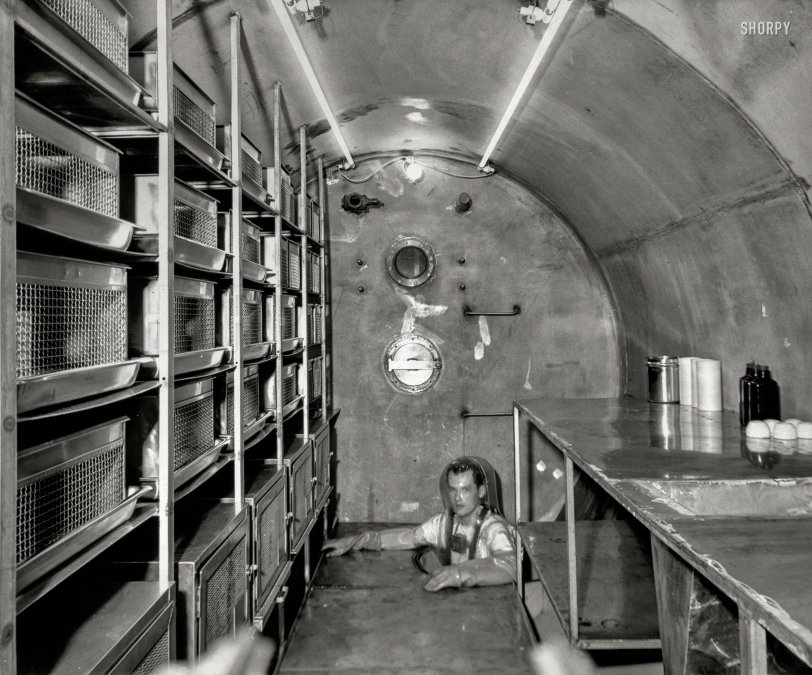


Framed or unframed, desk size to sofa size, printed by us in Arizona and Alabama since 2007. Explore now.
Shorpy is funded by you. Patreon contributors get an ad-free experience.
Learn more.

- Alas, hidden from view
- Exclusive pump
- Details, Details
- What's that building to the left of the tower?
- Coal Barges
- Bromo-Seltzer
- Inner harbor
- The Basin
- What a headache!
- Giant stepladder?
- Baldwin 62303
- Baldwin VO-1000
- Cold
- No expense spared
- Tough Guys
- Lost in Toyland
- And without gloves
- If I were a blindfolded time traveler
- Smoke Consumer Also Cooks
- Oh that stove!
- Possibly still there?
- What?!?
- $100 Reward
- Freeze Frame
- Texas Flyer wanted
- Just a Year Too Soon
- WWII -- Replacing men with women at the railroad crossing.
- Yes, Icing
- You kids drive me nuts!
- NOT An Easy Job
Print Emporium
The Chamber: 195x

From the Library of Congress archive comes this orphan image, circa 1953, with no caption or other identifying information. What could this young man who looks like one of Captain Video's ranger cadets be up to? View full size.
Those are Cold Cathode Lamps
This is a very unsettling picture having once done some electrical work in a lab where Rabbits were kept in cages like these. The overhead lights appear to be Germicidal Cold Cathode Lamps as evidenced by the "Thimble" like end of the tube. They are much more robust then their standard florescent cousins, able to take mechanical shock and extreme changes in environment. They are common in outdoor signs. This would support the idea that this was an environmental test chamber chamber. Here is a link to a modern Germicidal version.
https://ultraviolet.com/cold-cathode-germicidal-uv-lamps/
Life Without Germs In a Laboratory
A companion photo illustrates an item on this page of the November 1950 issue of Popular Mechanics.
Wouldn't they break?
Just wondering, if the vessel was used for pressure experiments, wouldn't the fluorescent tubes break?
Experimental chamber
I'm really puzzled with this one. It looks to be some sort of holding chamber with small animal cages. It might be able to withstand some variation in air pressure, though it does not seem reinforced enough to handle extreme variations (but then too, neither are animals.) Possibly meant to test toxic chemicals introduced into the chamber's atmosphere? But why would entry be via a hatch in the deck? It almost looks like a vessel or aircraft but the construction is more like a standing structure. In any event, something about it is worrisome enough to require the young fellow to be dressed up in what appears to be a type of early environmental hazard suit. I'll be really curious to see what it turns out to be.
Animals
Is the clue in the Tags header? If so, are these cages? And is that guy cleaning and / or feeding in the latest height of security / hygiene / modern science? And why do I fear there's something experimental / genetic / virus involved? This image is both wacky and sinister.
Danger Will Robinson!
Looks as though he's wearing some kind of old-school hazmat suit. I would say it's some kind of laboratory where animal experiments are done. The appearance of the place would lead me to think the lab animals are injected with extremely nasty chemicals or the like.
Silent and effective, but at a cost
Shown here is the 1949 Rocket H-model submarine, probably undergoing testing trials in Long Island Sound.
Powered by several hundred hamsters, or in the more powerful Rocket J version, squirrels, this 65-foot sub was silent and capable of surprising speed. The cages on the left of this photo show the propulsion-containment cages.
What Mr. Rocket, the inventor and developer, hadn't considered was the remarkable stench of having that many small animals confined to an airtight capsule (which a submarine essentially is) for days at a time. That's why the young man is wearing protective gear. This unusual concept was abandoned after President Eisenhower went on a dive in 1954 and ordered the project scrapped for olfactory reasons.
Ranger Cadet Bubblehead
is entering the intergalactic conduit to repair the collapsible cable, before it does. This is an interesting shot as it shows a rare voice actuated chest decoder, as a traditional ring or badge model would be hard to impossible to use with those gloves.
Nuclear Submarine tests
My guess, testing for underwater endurance for the nuclear submarine program. It appears to be animal cages to the left, and entrance and exit through an underwater hatch.
Under Pressure
Well, our friend is wearing an environment suit, and to the left are old-fashioned lab animal cages in racks. The end of the cylinder above the scientist features a small and very beefy porthole, suggesting this is a pressure vessel of some sort, most likely a hyperbaric (or hypobaric) chamber. All surfaces are stainless steel, and thus easily decontaminated. So, I'm guessing this is an experiment relating to altitude or depth (i.e. environmental pressure) where a pathogen-free environment is important. Maybe a study of altitude sickness?
























On Shorpy:
Today’s Top 5